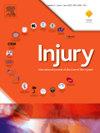股骨远端干骺端骨折间隙多宽是内翻塌陷和固定失败的高风险?有限元研究。
IF 2.2
3区 医学
Q3 CRITICAL CARE MEDICINE
Injury-International Journal of the Care of the Injured
Pub Date : 2025-02-01
DOI:10.1016/j.injury.2024.112091
引用次数: 0
摘要
背景:严重的干骺端粉碎和股骨远端相当大的骨缺损是固定失败的高风险。到目前为止,还没有确切的粉碎和骨质流失的大小被确定为增加固定结构的指征。本研究旨在探讨干骺端间隙宽度、工作长度和螺钉分布对固定结构稳定性的影响。方法:采用11孔股骨远端锁定加压钢板(LCP-DF)稳定0-80 mm干骺端间隙宽度的股骨骨折的有限元模型。不同的工作长度和螺杆分布由三种不同的螺杆配置:9-10-11(长工作长度,群集螺杆),8-10-11和7-9-11(短工作长度,分散螺杆)。生理加载条件包括等效von Mises (EQV)应力、骨应力和骨折应变来评估生物力学性能。结果:EQV应力随干骺端间隙宽度0 ~ 20mm的增大而增大。当干骺端间隙宽度大于30 mm时,EQV应力值处于相同水平,特别是在螺钉配置9-10-11时。螺纹结构7-9-11产生的弹性应变最小。干骺端间隙宽度为0 mm时骨应力最小。在10- 80mm干骺端间隙内,骨应力值大小相似。结论:30mm宽的干骺端间隙宽度和较长的工作长度存在内翻塌陷和固定失败的风险。扩展螺钉工作长度短,EQV应力小,骨应力小,骨折稳定性好。本文章由计算机程序翻译,如有差异,请以英文原文为准。
How wide of a distal metaphyseal femoral fracture gap is a high risk of varus collapse and fixation failure? A finite element study
Background
Severe metaphyseal comminution and sizable bone defect of the distal femur are high risks of fixation failure. To date, no exact magnitude of comminution and bone loss is determined as an indication for augmentation of fixation construct. The present study aimed to investigate the influence of metaphyseal gap width, working length, and screw distribution on the stability of the fixation construct.
Methods
A finite element model of a fractured femur with 0–80 mm metaphyseal gap width stabilized by an 11-hole distal femur locking compression plate (LCP-DF) was generated. The different working length and screw distribution were created by three different screw configurations: 9–10–11 (long working length, cluster screw), 8–10–11, and 7–9–11 (short working length, spreading screw). Physiological loading conditions were applied to evaluate biomechanical performance including equivalent von Mises (EQV) stress, bone stress, and fracture strain.
Results
The EQV stress increased accordingly to a metaphyseal gap width of 0–20 mm. The EQV stress values were at the same levels for 30-mm metaphyseal gap width and higher, particularly in screw configuration 9–10–11. Screw configuration 7–9–11 produced the lowest elastic strain. A 0-mm metaphyseal gap width presented the lowest bone stress. Bone stress values were in a similar magnitude across a 10–80 mm metaphyseal gap.
Conclusion
The 30-mm and wider metaphyseal gap width with a long working length presented a risk of varus collapse and fixation failure. Short working length with spreading screw provided low EQV stress, low bone stress, and high fracture stability.
求助全文
通过发布文献求助,成功后即可免费获取论文全文。
去求助
来源期刊
CiteScore
4.00
自引率
8.00%
发文量
699
审稿时长
96 days
期刊介绍:
Injury was founded in 1969 and is an international journal dealing with all aspects of trauma care and accident surgery. Our primary aim is to facilitate the exchange of ideas, techniques and information among all members of the trauma team.

 求助内容:
求助内容: 应助结果提醒方式:
应助结果提醒方式:


